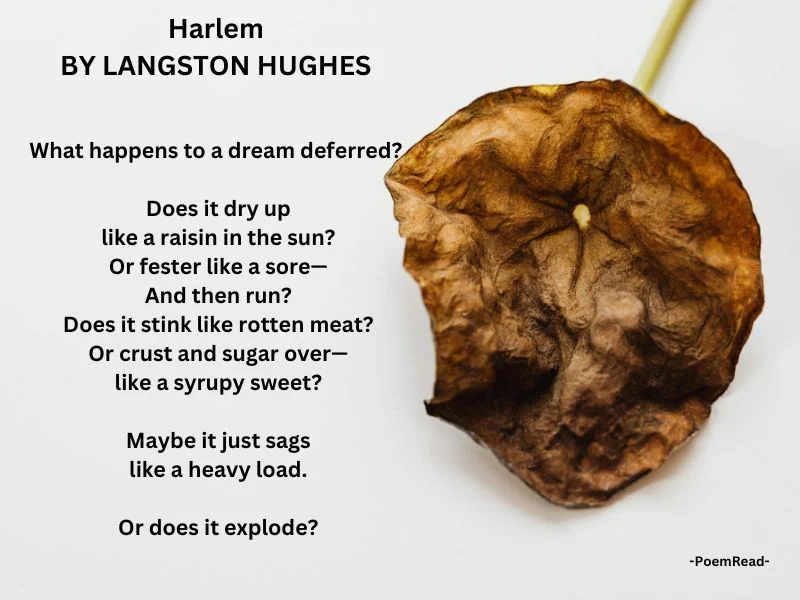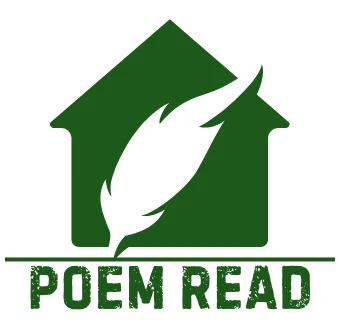
Explore Langston Hughes’ celebrated poem “Harlem,” where deferred dreams hold the spotlight. Through vivid imagery and compelling questions, Hughes encourages us to consider the impact of unfulfilled aspirations. “Harlem” uses metaphors and symbolism to delve into the complexities of unrealized dreams, striking a chord with readers. Join us as we unravel Hughes’ poetic genius, sparking reflection on life’s choices and the pursuit of dreams.
In this blog post, we will examine the background of the author, the subject of the poem, its context, theme, and tone, as well as its form and structure. Through a line-by-line analysis, we will uncover the poetic and literary devices used by Hughes. Furthermore, we will explore the implications and meanings of this thought-provoking piece of literature.
Harlem
BY LANGSTON HUGHES
What happens to a dream deferred?
Does it dry up
like a raisin in the sun?
Or fester like a sore—
And then run?
Does it stink like rotten meat?
Or crust and sugar over—
like a syrupy sweet?
Maybe it just sags
like a heavy load.
Or does it explode?
Content
- About the Author: Langston Hughes
- Subject of "Harlem"
- Context of the Poem
- Theme and Tone of "Harlem"
- Form and Structure of "Harlem"
- Persona, setting, and narrative of Langston Hughes' poem "Harlem."
- Line-by-Line Analysis of "Harlem"
- Poetic and Literary Devices Used in "Harlem"
- Implications and Meanings of "Harlem"
- Interactive Summary of "Harlem"
About the Author: Langston Hughes
Langston Hughes, born on February 1, 1902, was an influential American poet, novelist, and playwright. He was a prominent figure of the Harlem Renaissance, a cultural movement that celebrated African American art, music, and literature in the 1920s and 1930s. Hughes’ works often reflected the experiences and struggles of African Americans, giving voice to their hopes, dreams, and frustrations. His powerful poetry continues to resonate with readers worldwide.
Subject of “Harlem”
“Harlem” by Langston Hughes is a powerful piece that addresses the subject of deferred dreams. It specifically focuses on the dreams of racial equality for the African American community. The poem is part of Hughes’ larger work, “Montage of a Dream Deferred,” which draws inspiration from blues and jazz music. Its aim is to capture the essence of the black community’s experience in Harlem.
The recurring question, “What happens to a dream deferred?” captures the main theme of the poem. It revolves around the delay and potential outcomes of dreams left unfulfilled.
The poem uses vivid imagery and similes to explore the various outcomes of putting off these dreams. The poem suggests that deferred dreams can “dry up,” “fester,” “stink,” “crust and sugar over,” “sag,” or “explode.” Each metaphor vividly portrays frustration and decay while also hinting at the potential for an eventual, possibly explosive, confrontation.
Context of the Poem
The context of “Harlem” is deeply rooted in the historical and cultural backdrop of the Harlem Renaissance and the Civil Rights Movement. Written in 1951, the poem reflects the sentiments of a community that has been promised equality and opportunity but continues to face systemic barriers and discrimination. African Americans made significant contributions to intellectual and artistic expression during the Harlem Renaissance. However, society as a whole frequently ignored and marginalized their achievements.
Although Hughes was highly regarded within the African American community, he faced challenges as the predominantly white society of his time failed to fully recognize his literary brilliance. This personal experience, coupled with the collective struggle for civil rights, informs the powerful message of “Harlem.” The poem acts as a call to recognize and confront deferred dreams of equality and justice. It warns of the consequences if these dreams remain unacknowledged.
Theme and Tone of “Harlem”
Theme
The major themes of “Harlem” include delay, sadness, and dreams. The poem speaks to the oppression of African Americans and suggests that their goals often remain unattainable and lose their significance over time. It mourns the hopes and dreams that black Americans have had to sacrifice because of racism and discrimination. The recurring theme of “dream deferred” captures the frustration and disappointment of unfulfilled aspirations, especially in the context of civil rights.
The poem also touches on the theme of the American Dream, the national ethos of the United States that promises prosperity and success through hard work. However, for the African American community during Hughes’ time, this dream was consistently out of reach due to systemic barriers.
Tone
The tone of “Harlem” is described as anticipatory and prophetic. Hughes uses rhetorical questions to map out a series of potential outcomes for the future of Harlem and its residents. The poem’s anticipatory nature is not merely hypothetical; it is a concrete exploration of what will happen if the conditions of life for black folks in Harlem do not improve.
The tone shifts from hopeful to somber and then to a sense of resignation as the poem progresses. Initially, there is a sense of hope that the deferred dreams might still be realized. However, as the poem continues, the imagery becomes more negative, suggesting decay and waste, leading to a tone of sadness. The final line, “Or does it explode?” introduces a tone of warning, implying that ignoring these deferred dreams could lead to an explosive outcome.
Form and Structure of “Harlem”
Structure
The poem is written in free verse, which means it lacks a fixed rhyme scheme or regular meter. Unlike traditional forms like sonnets or ballads, Hughes allows the lines to flow naturally without adhering to strict patterns. This choice reflects the instability and unpredictability of the central theme: deferred dreams.
The poem consists of a single stanza, but its lines vary in length. Hughes deliberately avoids a uniform structure, emphasizing the organic flow of thought. The irregular pattern mirrors the complexity of the emotions and experiences he seeks to convey. Furthermore, by breaking away from formal structures, Hughes captures the essence of deferred dreams—their weight, frustration, and potential consequences.
Each line of the poem is a question, creating a series of inquiries that drive the entire work. The opening line sets the tone: “What happens to a dream deferred?” These questions invite readers to engage actively with the text, encouraging personal reflection and interpretation.
Rhyme Scheme
“Harlem” does not adhere to a strict rhyme scheme, although there are instances of slant rhyme and near rhyme. For example, “sun” and “run” create a partial rhyme, while “sweet” and “load” offer a similar near rhyme. This subtle use of rhyme adds a musical quality to the poem without detracting from its conversational style.
This absence of rhyme allows Hughes to emphasize certain words and phrases, enhancing their emotional weight and impact on the reader. The lack of rhyme contributes to the poem’s raw and urgent quality. The absence of rhyme and regularity amplifies the poem’s emotional intensity, making it resonate deeply with readers.
Meter
The meter in Langston Hughes’ poem “Harlem” is a significant aspect of its structure. The poem typically uses free verse, lacking a consistent metrical pattern. However, the opening line is an exception. It’s written in iambic tetrameter, consisting of four iambs. A stressed syllable follows an unstressed one in each iambic foot.
By starting the poem with a line that has a clear metrical form, Hughes sets up an expectation for rhythmic regularity. However, he immediately subverts this expectation. He achieves this by using lines without a consistent meter, creating a sudden shift that mirrors the poem’s theme of disruption and uncertainty. The use of end-stopped lines with dashes and questions further breaks the rhythm, amplifying the sense of fragmentation and discontinuity.
The meter of “Harlem” mirrors the poem’s content, highlighting the unpredictable nature of deferred dreams. It also emphasizes the potential for disorder and chaos that can arise when those dreams are not realized. Hughes’ strategic use of meter, combined with the poem’s free verse structure, contributes to the overall impact and depth of “Harlem.”
Line Breaks and Pauses
Hughes utilizes line breaks strategically to create pauses and emphasize certain words or phrases. For instance, a line break follows the phrase “Does it stink like rotten meat?” which heightens the impact of the question and allows the reader to consider its imagery.
Punctuation
The poem features minimal punctuation, primarily using dashes and question marks. This lack of punctuation contributes to the poem’s fluidity and conversational tone, allowing for a seamless flow of thoughts and ideas.
Persona, setting, and narrative of Langston Hughes’ poem “Harlem.”
Persona
The persona in “Harlem” isn’t explicitly defined by Hughes. However, it’s often interpreted as a collective voice speaking for the African American community, especially those living in Harlem during the Harlem Renaissance. The speaker does not use the first-person pronoun “I.”
This suggests that the poem is not about an individual’s experience but rather a shared concern among the community. The persona’s questions are rhetorical, reflecting the collective contemplation of the community on the fate of their deferred dreams.
Setting
The setting of “Harlem” is the neighborhood of Harlem, New York, during the early 1950s. During the Harlem Renaissance, Harlem flourished as a cultural center for African Americans. However, it was also a time when promises of equality and racial injustice went unfulfilled. The title of the poem, “Harlem,” firmly ties it to a specific location that held great significance in the African American experience and the fight for civil rights. The setting isn’t merely a physical place but also a symbol of the wider social and historical context of the African American quest for equality.
Narrative
“Harlem” does not follow a traditional narrative structure with a clear beginning, middle, and end. Instead, it presents a series of rhetorical questions that explore the potential consequences of deferred dreams. The narrative of “Harlem” encourages contemplation and serves as a warning. It urges readers to reflect on the emotional and societal consequences of delaying the realization of dreams. The poem’s narrative reflects on the community’s past experiences while also offering a prophetic glimpse into the future. It suggests that if dreams remain deferred, there could be explosive consequences.
In summary, “Harlem” uses a collective persona to voice the concerns of the African American community in the historical and cultural setting of Harlem. The narrative is built around rhetorical questions that challenge the reader to think about the repercussions of deferred dreams, both on an individual and societal level. The poem’s power is found in its capacity to evoke strong emotions. It also encourages contemplation about racial inequality and justice issues.
Line-by-Line Analysis of “Harlem”

“What happens to a dream deferred?”
The first line of Langston Hughes’ poem “Harlem,” “What happens to a dream deferred?” is a powerful opening that introduces the central theme of the poem: the deferral of dreams and its potential consequences. This line sets the stage for the subsequent exploration of the emotional and societal impact of postponed aspirations.
The word “deferred” is key, as it implies a delay or postponement rather than a cancellation. The dream is not dead; it’s merely put on hold. However, the implications of this postponement are not neutral. The term carries a weight of expectation and the potential for negative outcomes if those dreams are not eventually realized.
The dream mentioned in the poem serves as a metaphor for the collective aspirations of African Americans. This is especially true during the Harlem Renaissance, a period when black culture thrived despite ongoing racial oppression. The poem raises questions about the social consequences of deferred dreams. It hints that these deferred dreams may lead to a buildup of tension, potentially resulting in explosive outcomes.
Essentially, this line summarizes the poem’s exploration of both the African American experience and the broader human condition. It reflects how unfulfilled dreams can lead to frustration, disillusionment, and even a crisis if they remain unaddressed.
“Does it dry up like a raisin in the sun?”
Expanding on the analysis of Langston Hughes’ “Harlem,” these lines further extend the metaphor of a deferred dream. They also introduce a simile, enhancing our grasp of the poem’s theme. This line compares the fate of a postponed dream to a raisin drying up in the sun. The imagery is striking, portraying the transformation of a grape, initially full of potential, into something shriveled and diminished. Similarly, the dream begins brimming with possibilities but loses its vitality due to neglect and delay.
The word “like” in this context signals the use of a simile, drawing a comparison between the dream and the raisin. This invites readers to reflect on the meaning behind this comparison. The sun, usually associated with life and growth, takes on a paradoxical role, leading to desiccation and decay in the raisin. This suggests that the environment where the dream exists, possibly one of racial inequality or social injustice, doesn’t nurture the dream but drains it of vitality.
The choice of a raisin holds cultural significance, as raisins are often linked to aging and loss of freshness. In the context of the poem, this mirrors the historical and ongoing struggles of African Americans. It highlights that their dreams of equality and justice continually face postponement. The line’s tone carries sadness and resignation, highlighting the harsh reality of unfulfilled dreams.
In summary, the second line of “Harlem” uses a simple yet potent simile. This simile illustrates the diminishing effect of deferred dreams. It sets a melancholic tone for the poem and emphasizes the theme of the possible consequences of delay, both on an individual and societal level.
“Or fester like a sore— and then run?”
Following the analysis of the second line of Langston Hughes’ “Harlem,” the third line, “Or fester like a sore—And then run?” introduces a new simile to the contemplation of a dream deferred. This line suggests that a postponed dream might not just wither but could also become infected, like a sore.
The use of the word “fester” implies a process of worsening or rotting, indicating that deferred dreams can cause emotional distress and pain. The addition of “And then run?” at the end of the line suggests the sore is breaking open. This could symbolize a sudden and possibly unexpected release of pent-up frustration linked to unfulfilled aspirations.
This imagery is powerful because it contrasts with the dried-up raisin in the previous line. It presents a more active and unsettling consequence of neglecting one’s dreams. The sore that festers and runs is a compelling image that cannot be overlooked. It demands attention, indicating that deferred dreams will eventually assert themselves, often in unpleasant ways. The line’s tone is one of warning, hinting at the urgency of addressing these dreams before they reach a critical point of distress.
“Does it stink like rotten meat?”
This line adds another simile to the sequence of possible outcomes for a deferred dream. This line starkly contrasts with the previous images, shifting from the painful sore to the repulsive scent of decay. The comparison to “rotten meat” elicits a strong, visceral response. It’s an odor that cannot be ignored, invading and permeating the senses.
This line implies that deferred dreams can transform from a personal burden, as indicated by the festering sore, into a societal problem. They can become noticeable and offensive to everyone. The use of the word “stink” conveys a deep sense of wrongdoing. It signals that something that should have been vibrant and full of life has been allowed to spoil.
The dream, once full of promise, has become something that repels rather than attracts, indicating a deep corruption of potential. This impactful imagery further develops the poem’s theme of the negative transformation of deferred dreams. Furthermore, It brings a public, shared consequence to the personal and hidden implications introduced earlier.
“Or crust and sugar over— like a syrupy sweet?”
Moving forward from previous unsettling imagery, this line presents a contrasting image through another simile. This line implies that a deferred dream might not only decay but could also appear deceptively attractive on the surface, like a dessert that has formed a crust.
The use of “crust and sugar over” implies a The phrase “crust and sugar over” implies a process of hardening or superficial coating. This could represent how a long-unfulfilled dream might develop a facade of being pleasant or resolved. However, likening it to a “syrupy sweet” implies an underlying bitterness. This suggests that beneath the surface, the deferred dream is not as pleasant as it may seem.
This line introduces the idea that deferred dreams may not always have clearly negative outcomes. Instead, they can take on an appearance that hides the frustration and despair lying beneath. The tone here is ironic, as the positive image of sweetness is undermined by the acknowledgment that it’s just a facade for a less pleasant reality. The poem further explores the theme of deferred dreams’ transformation, highlighting how they can become distorted in different ways, some more subtly harmful than others.
“Maybe it just sags like a heavy load.”
Here, the poem’s imagery shifts from deceptive sweetness to a metaphor of burden and exhaustion. This line suggests that a deferred dream might not result in dramatic decay or a misleading facade. Instead, it may manifest as an oppressive weight.
The word “maybe” brings a tone of speculation, suggesting uncertainty about the outcome. “Sags” conveys a sense of yielding under pressure, burdened by the weight of unfulfilled aspirations. The comparison to a “heavy load” is fitting, as it mirrors the physical and psychological burden that deferred dreams can place on an individual or a community.
Unlike the earlier lines that show the dream transforming into something else, this line presents the dream as a burden to be carried. It suggests a weariness that arises from prolonged postponement. The dream, once a source of hope and motivation, has become a source of fatigue, a relentless and cumbersome presence that one cannot easily shed.
This line adds to the poem’s examination of the different states that deferred dreams can bring about. These states aren’t just harmful but also exhausting and soul-crushing.
“Or does it explode?
The final line, “Or does it explode?” introduces a dramatic shift in the poem’s imagery and potential outcomes for a dream deferred. This line stands out both in its brevity and its stark, violent imagery. The word “explode” suggests that deferred dreams can only be contained for so long before they reach a breaking point. Unlike the previous lines, which present gradual deterioration or a burdensome weight, this line implies a sudden and potentially destructive outcome.
The use of “Or” at the beginning of the line presents this scenario as an alternative to the previous ones, highlighting the unpredictability of the consequences of this situation. The explosion could symbolize a social uprising or a personal breakthrough, where the pent-up frustration and aspiration for change can no longer be suppressed.
The poem ends powerfully, leaving readers with a sense of urgency and a warning. It suggests that deferred dreams require attention and action to prevent unforeseen and explosive consequences.
In summary, the seventh line of “Harlem” captures the critical message of the poem: the potential for dramatic and revolutionary change when dreams are continually deferred. It serves as a poignant reminder of the need for progress and the inherent risks of allowing dreams to go unfulfilled. This line captures the emotional intensity of Hughes’ poem with its evocative language. It also emphasizes the call to action that echoes throughout the poem.
Poetic and Literary Devices Used in “Harlem”
Rhetorical Questions
The poem follows a structure of rhetorical questions, which aren’t meant to be answered but to stimulate thought and emphasize the central theme of deferred dreams. For instance, the opening line, “What happens to a dream deferred?” encourages readers to consider the repercussions of delayed aspirations.
Metaphor
Metaphors are comparisons that do not use “like” or “as,” and Hughes employs them to convey deeper meanings. In the line “Or fester like a sore—And then run?” he compares a deferred dream to a sore that festers and worsens if not treated. This metaphorical language suggests that ignoring our dreams can lead to emotional pain and turmoil.
Parallelism
Hughes uses parallelism to create a rhythmic structure that mirrors the musical patterns of blues and jazz. This device is evident in the repeating structure of the rhetorical questions, which follow a pattern of “Does it…? Or…?”. For instance, “Does it dry up like a raisin in the sun? Or fester like a sore—And then run?”
Simile
The poem introduces several similes, each comparing the deferred dream to a vivid image. The first simile is “like a raisin in the sun,” suggesting that the dream might shrivel and lose its vitality over time.
Other similes include “fester like a sore,” “stink like rotten meat,” and “crust and sugar over—like a syrupy sweet.” These similes evoke sensory experiences and illustrate the consequences of neglected dreams.
Imagery
Imagery refers to the use of descriptive language to create sensory experiences for the reader. When Hughes asks if a deferred dream “stink[s] like rotten meat,” he’s using imagery to make us imagine the unpleasant smell of decaying meat. This imagery helps us understand the negative feelings associated with unfulfilled dreams.
Enjambment
Enjambment is the continuation of a sentence or thought across line breaks. Hughes uses enjambment to maintain a smooth flow of ideas and create a rhythmic effect. For example, in the line “Or crust and sugar over—like a syrupy sweet?” the sentence flows seamlessly from one line to the next, maintaining a natural reading pace.
Alliteration
Langston Hughes employs alliteration, the repetition of consonant sounds at the beginning of words, to enhance the musicality and rhythm of the poem. For example, in the line “crust and sugar over,” the repeated “s” sound creates a soothing and rhythmic effect, contributing to the overall tone of the poem.
Consonance and Assonance
Hughes utilizes consonance, which involves the repetition of consonant sounds within or at the end of words, to add emphasis and create a harmonious flow in “Harlem.” An example of consonance can be found in the line “Does it stink like rotten meat?” where the repeated “t” and “k” sounds in “stink,” “rotten,” and “meat” create a harsh yet resonant tone that enhances the imagery of decay.
Assonance, the repetition of vowel sounds within words, is subtly incorporated to create a sense of unity and coherence. For instance, in the line “Or crust and sugar over—like a syrupy sweet?” the repeated “u” sound in “crust,” “sugar,” and “over” adds a smooth and melodic quality to the verse, complementing the harsher consonance and alliteration.
Allusion
Hughes makes use of allusion, referencing other literary works or cultural elements, to enrich the thematic depth of “Harlem.” For instance, the phrase “like a raisin in the sun” alludes to Lorraine Hansberry’s play “A Raisin in the Sun,” which explores similar themes of aspiration and racial challenges. This allusion adds layers of meaning and cultural resonance to Hughes’ exploration of deferred dreams and societal struggles.
Furthermore, the poem alludes to the biblical proverb “Hope deferred makes the heart sick,” which adds a layer of depth to the theme of deferred dreams. This allusion connects the poem to a broader cultural and spiritual context.
Free Verse
“Harlem” is written in free verse, which means it does not adhere to a strict metrical pattern or rhyme scheme. This form allows Hughes greater flexibility in expression and mirrors the unpredictable nature of the poem’s subject matter.
End-Stopped Lines
Many of the lines in the poem are end-stopped, meaning they conclude with punctuation that creates a pause. This technique allows each image and idea to resonate fully before moving on to the next.
Implications and Meanings of “Harlem”

The poem “Harlem” by Langston Hughes is an exploration of the consequences of deferred dreams, particularly within the African American community. Let’s delve into the meanings and implications of this powerful piece.
The Weight of Deferred Dreams
At its core, “Harlem” grapples with the question of what happens when dreams are postponed or put on hold. The dream here is a metaphor for the aspirations of African Americans, particularly during the era of the Harlem Renaissance and leading into the Civil Rights Movement. The poem implies that when these dreams are deferred, they don’t just vanish; they undergo a transformation that can have negative repercussions.
Societal Reflection
The various outcomes Hughes presents for a deferred dream—drying up, festering, stinking, crusting over, sagging, or exploding—reflect the different ways unfulfilled aspirations can impact individuals and society. These images aren’t just literal descriptions; they also symbolize the emotional and psychological state of individuals whose dreams are consistently deferred.
Call to Action
The final line of the poem, “Or does it explode?” serves as a stark warning and a call to action. It suggests that there is a limit to how much people can bear when their dreams are deferred. This line implies that without change or progress, pent-up frustration and the desire for equality could lead to a social explosion. It suggests a demand for change that cannot be ignored.
Relevance to Modern Times
While “Harlem” was written in the context of the mid-20th century, its themes remain relevant today. The poem continues to resonate as it reflects on the broader human experience of deferred dreams. It also emphasizes the necessity for social justice and equality.
A Universal Message
Hughes’ poem goes beyond its historical context to convey a universal message. It stresses the significance of pursuing one’s dreams and warns of the risks of deferring them. It speaks to the resilience of the human spirit and the ongoing struggle for a more equitable society.
Interactive Summary of “Harlem”
Langston Hughes’ poem “Harlem,” also known as “A Dream Deferred,” is a powerful exploration of the fate of unfulfilled aspirations. Through a series of rhetorical questions, Hughes discusses the potential consequences of dreams that are postponed or neglected.
The poem employs similes, comparing deferred dreams to a raisin drying in the sun, a festering sore, rotten meat, a syrupy sweet, and a heavy load. These images evoke a range of sensory experiences and emotions, from decay and deterioration to deceptive sweetness and burdensome weight. Hughes’ use of free verse enables him to express these ideas smoothly, without the limitations of traditional rhyme or meter. Additionally, the end-stopped lines lend weight to each question and image.
The poem concludes with a striking final line that hints at the possibility of a deferred dream “exploding,” suggesting a dramatic and potentially violent outcome if dreams are consistently disregarded. “Harlem” serves as a reflection on the African American experience during the Harlem Renaissance.
It also provides a broader commentary on the human condition, emphasizing the significance of pursuing dreams and warning of the risks of deferring them. Hughes’ skillful use of poetic devices ensures that the poem deeply resonates with readers. It prompts reflection on themes of racial inequality and the pursuit of justice.
If you’re intrigued by themes of freedom and the African American experience, please read our analysis of “Dream Variations.” Discover the beauty and depth of Langston Hughes’ exploration of identity and aspiration.
RELATED POSTS
View all



